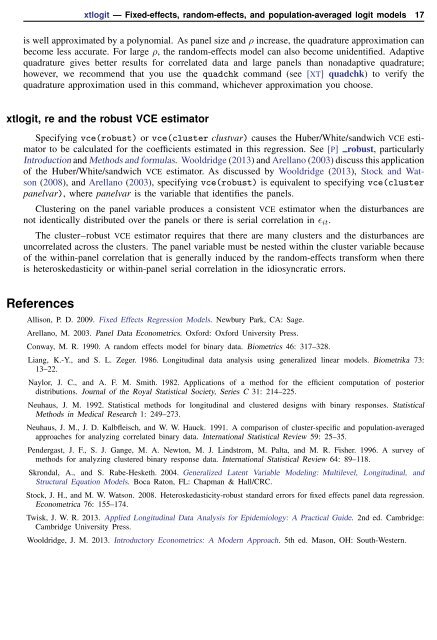xtlogit - Stata
xtlogit - Stata
xtlogit - Stata
You also want an ePaper? Increase the reach of your titles
YUMPU automatically turns print PDFs into web optimized ePapers that Google loves.
<strong>xtlogit</strong> — Fixed-effects, random-effects, and population-averaged logit models 17<br />
is well approximated by a polynomial. As panel size and ρ increase, the quadrature approximation can<br />
become less accurate. For large ρ, the random-effects model can also become unidentified. Adaptive<br />
quadrature gives better results for correlated data and large panels than nonadaptive quadrature;<br />
however, we recommend that you use the quadchk command (see [XT] quadchk) to verify the<br />
quadrature approximation used in this command, whichever approximation you choose.<br />
<strong>xtlogit</strong>, re and the robust VCE estimator<br />
Specifying vce(robust) or vce(cluster clustvar) causes the Huber/White/sandwich VCE estimator<br />
to be calculated for the coefficients estimated in this regression. See [P] robust, particularly<br />
Introduction and Methods and formulas. Wooldridge (2013) and Arellano (2003) discuss this application<br />
of the Huber/White/sandwich VCE estimator. As discussed by Wooldridge (2013), Stock and Watson<br />
(2008), and Arellano (2003), specifying vce(robust) is equivalent to specifying vce(cluster<br />
panelvar), where panelvar is the variable that identifies the panels.<br />
Clustering on the panel variable produces a consistent VCE estimator when the disturbances are<br />
not identically distributed over the panels or there is serial correlation in ɛ it .<br />
The cluster–robust VCE estimator requires that there are many clusters and the disturbances are<br />
uncorrelated across the clusters. The panel variable must be nested within the cluster variable because<br />
of the within-panel correlation that is generally induced by the random-effects transform when there<br />
is heteroskedasticity or within-panel serial correlation in the idiosyncratic errors.<br />
References<br />
Allison, P. D. 2009. Fixed Effects Regression Models. Newbury Park, CA: Sage.<br />
Arellano, M. 2003. Panel Data Econometrics. Oxford: Oxford University Press.<br />
Conway, M. R. 1990. A random effects model for binary data. Biometrics 46: 317–328.<br />
Liang, K.-Y., and S. L. Zeger. 1986. Longitudinal data analysis using generalized linear models. Biometrika 73:<br />
13–22.<br />
Naylor, J. C., and A. F. M. Smith. 1982. Applications of a method for the efficient computation of posterior<br />
distributions. Journal of the Royal Statistical Society, Series C 31: 214–225.<br />
Neuhaus, J. M. 1992. Statistical methods for longitudinal and clustered designs with binary responses. Statistical<br />
Methods in Medical Research 1: 249–273.<br />
Neuhaus, J. M., J. D. Kalbfleisch, and W. W. Hauck. 1991. A comparison of cluster-specific and population-averaged<br />
approaches for analyzing correlated binary data. International Statistical Review 59: 25–35.<br />
Pendergast, J. F., S. J. Gange, M. A. Newton, M. J. Lindstrom, M. Palta, and M. R. Fisher. 1996. A survey of<br />
methods for analyzing clustered binary response data. International Statistical Review 64: 89–118.<br />
Skrondal, A., and S. Rabe-Hesketh. 2004. Generalized Latent Variable Modeling: Multilevel, Longitudinal, and<br />
Structural Equation Models. Boca Raton, FL: Chapman & Hall/CRC.<br />
Stock, J. H., and M. W. Watson. 2008. Heteroskedasticity-robust standard errors for fixed effects panel data regression.<br />
Econometrica 76: 155–174.<br />
Twisk, J. W. R. 2013. Applied Longitudinal Data Analysis for Epidemiology: A Practical Guide. 2nd ed. Cambridge:<br />
Cambridge University Press.<br />
Wooldridge, J. M. 2013. Introductory Econometrics: A Modern Approach. 5th ed. Mason, OH: South-Western.
















